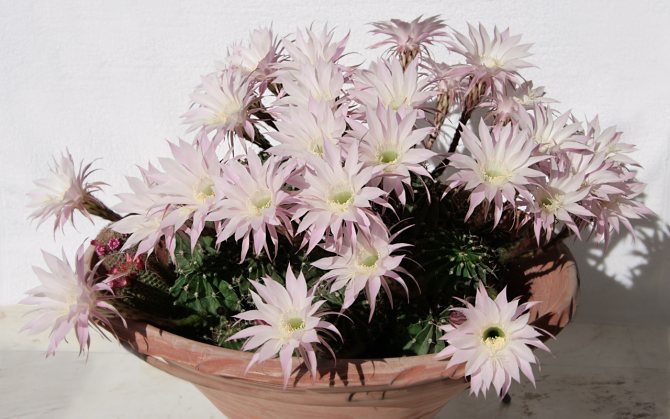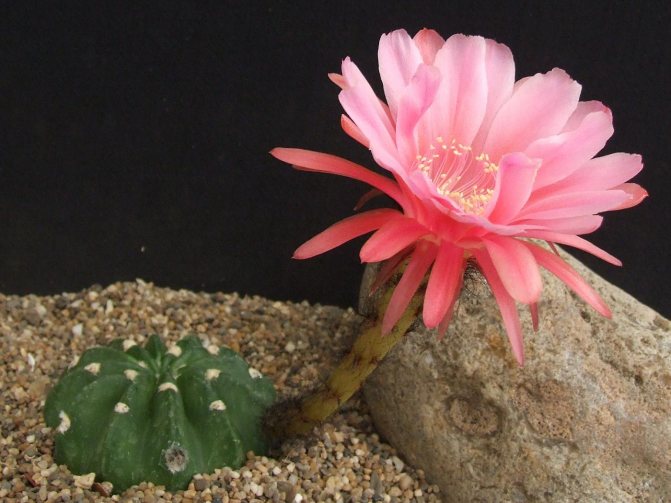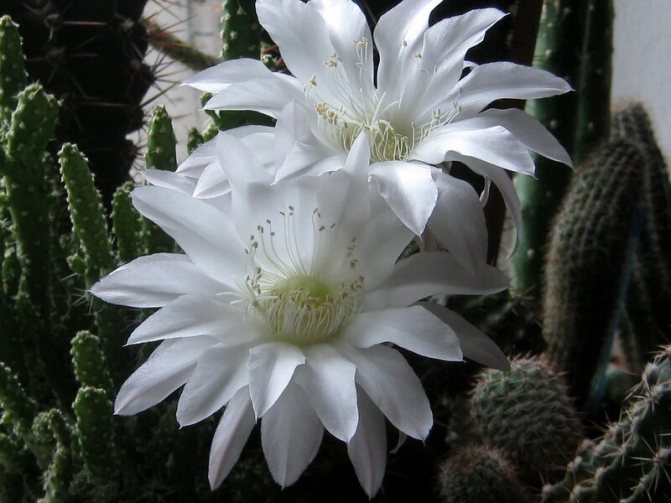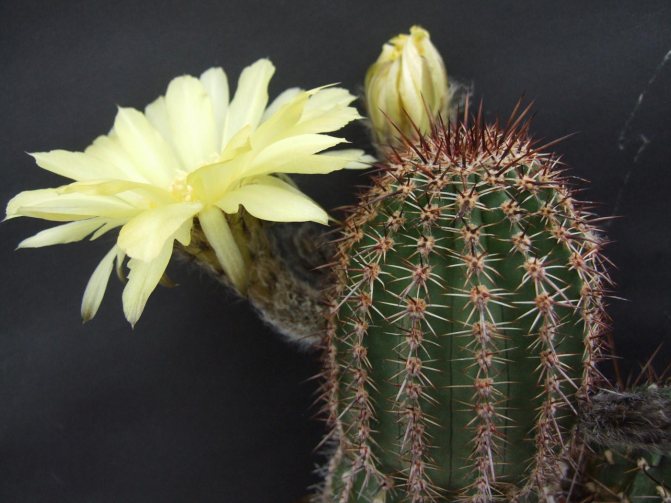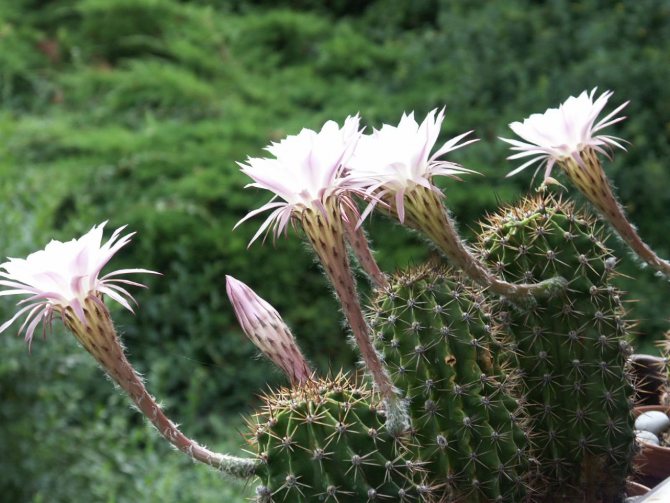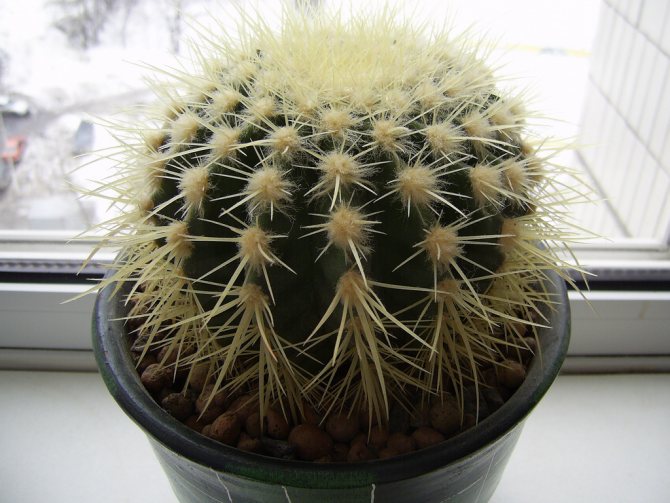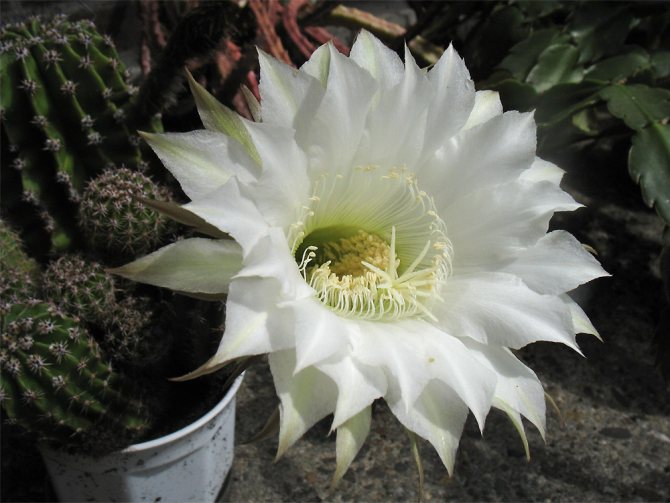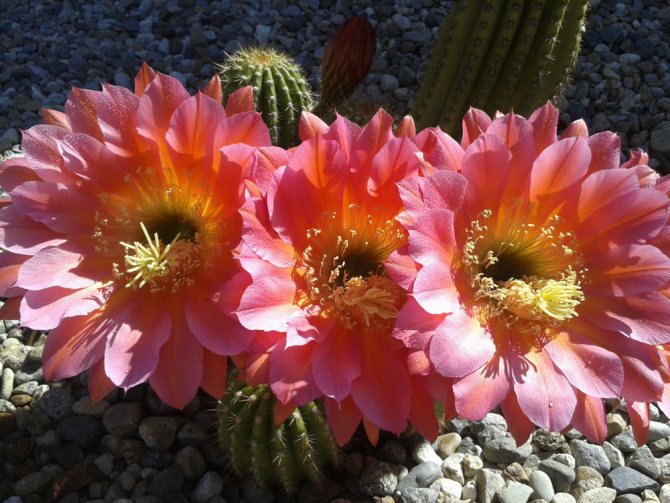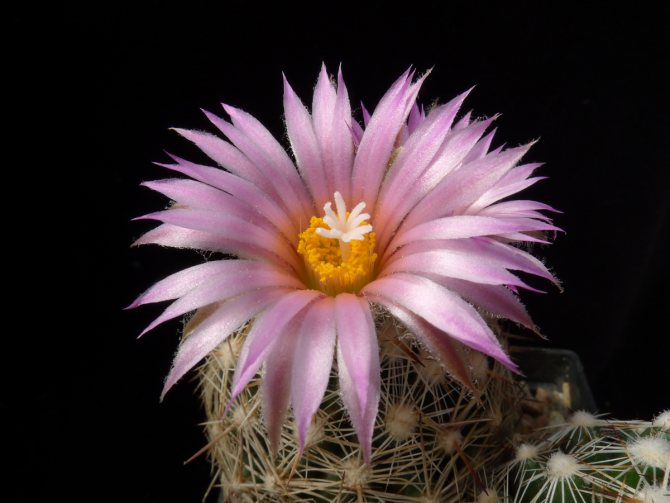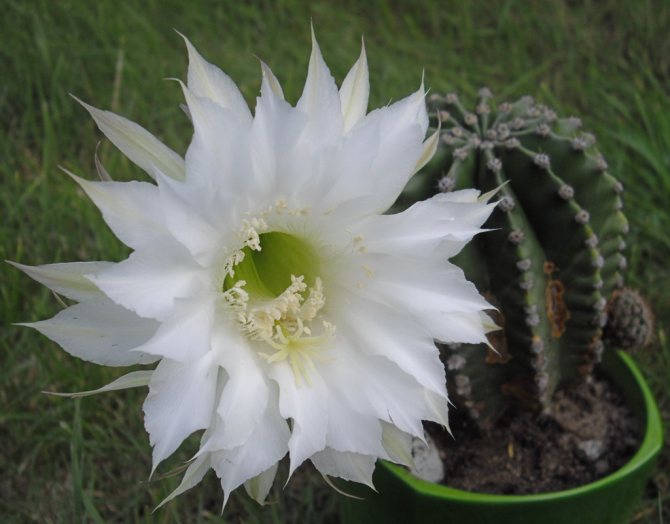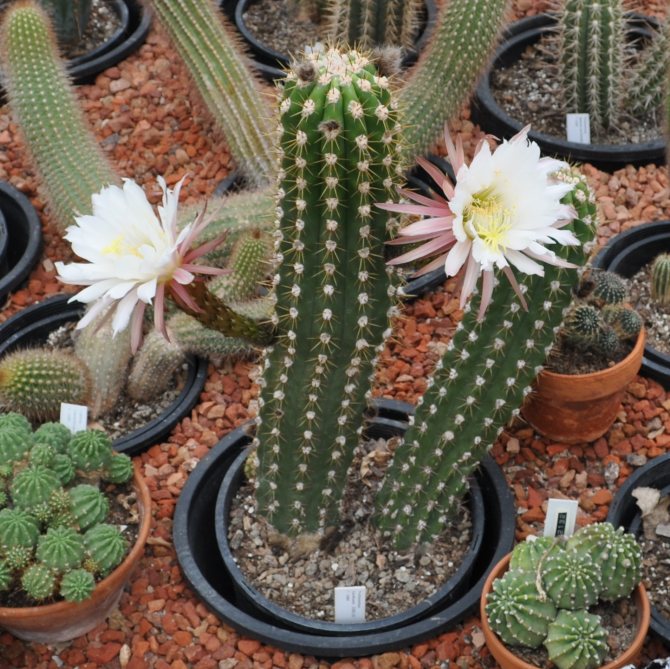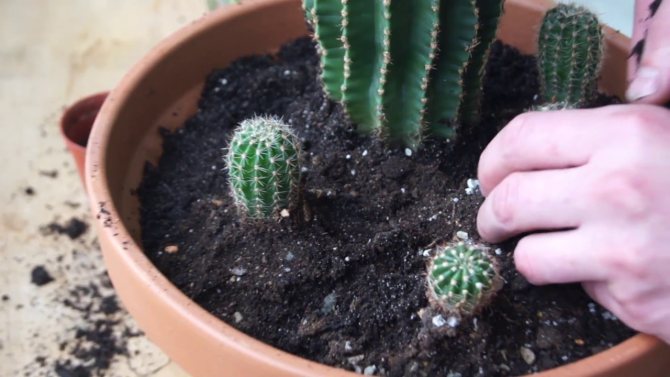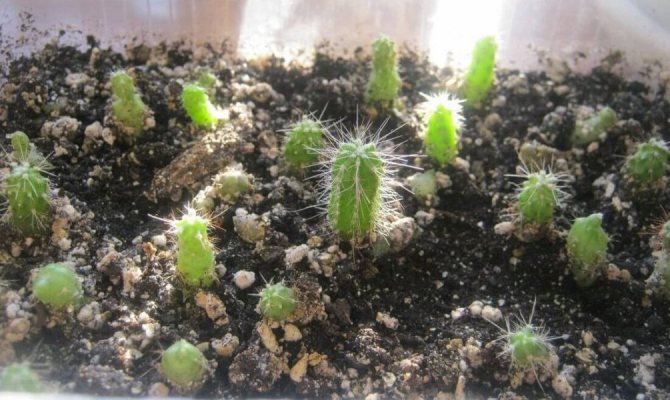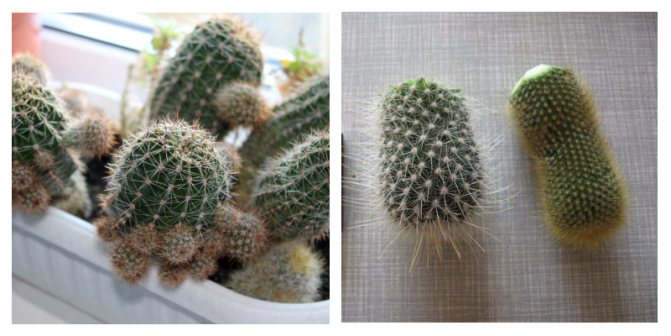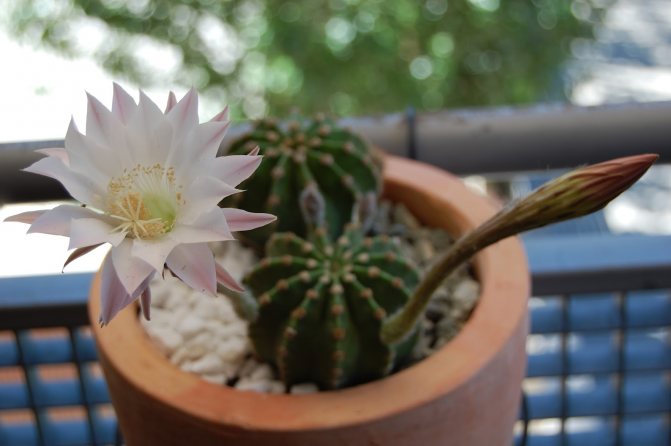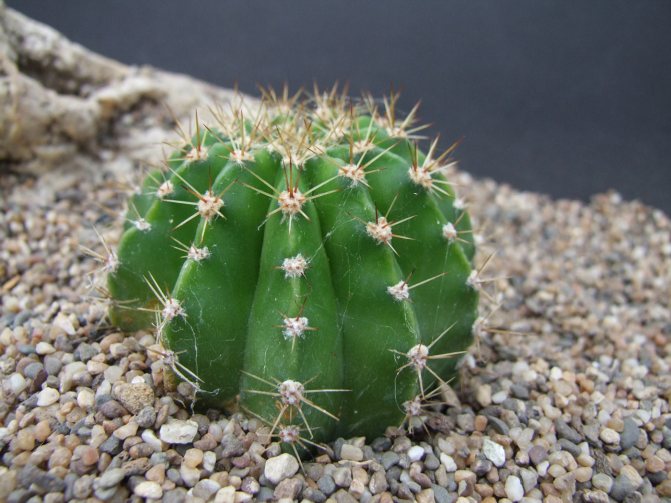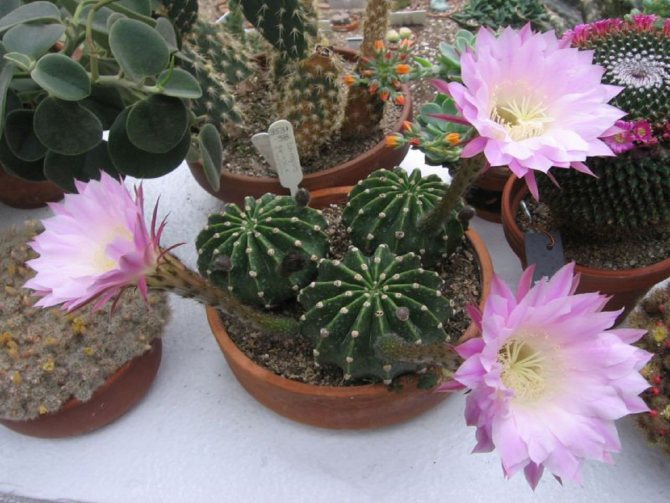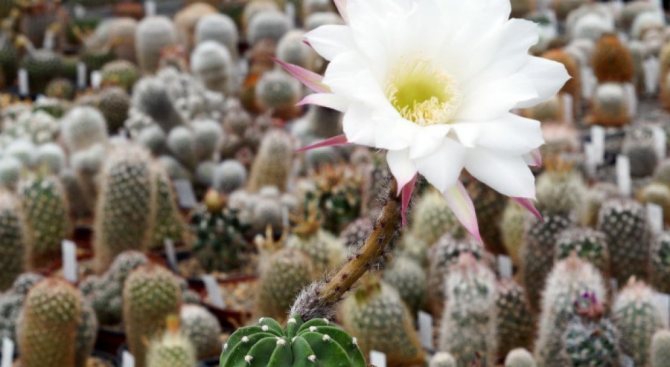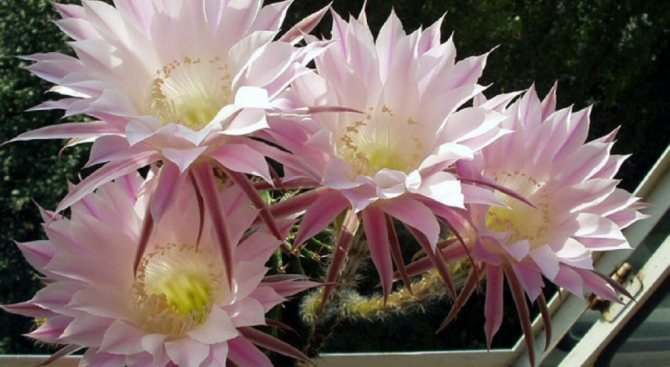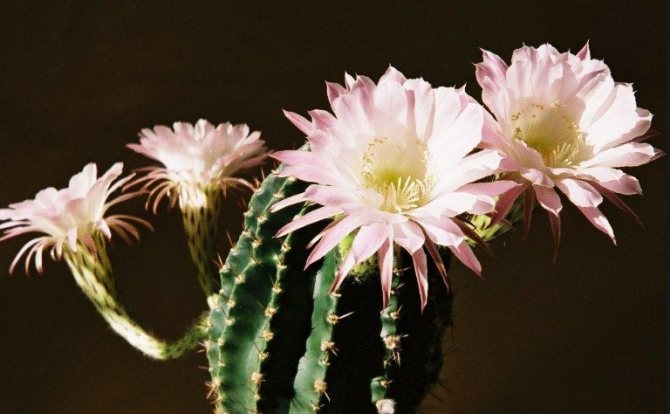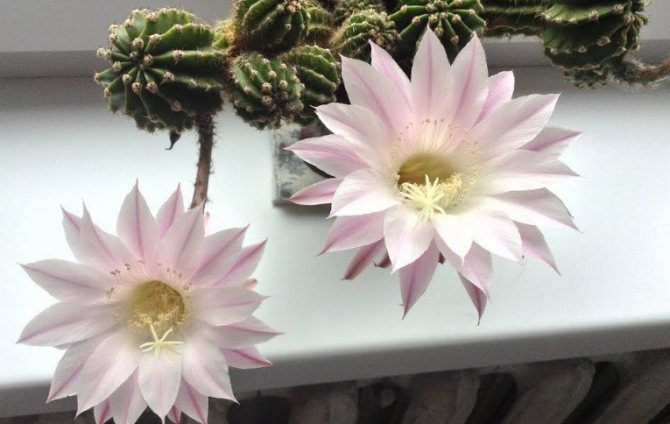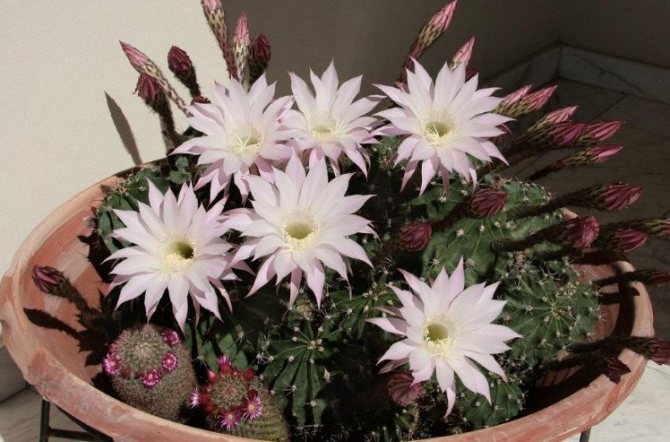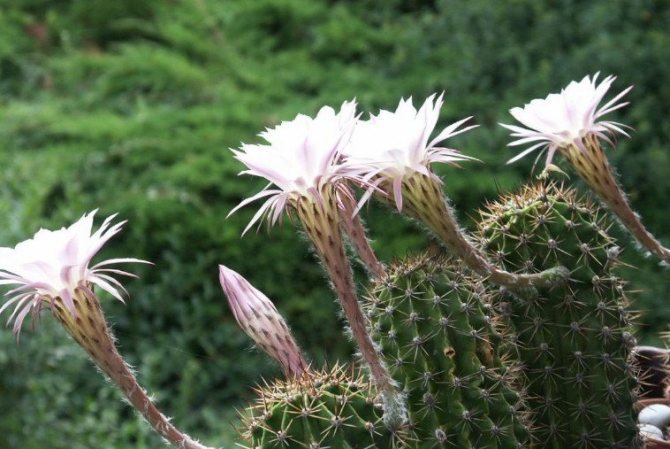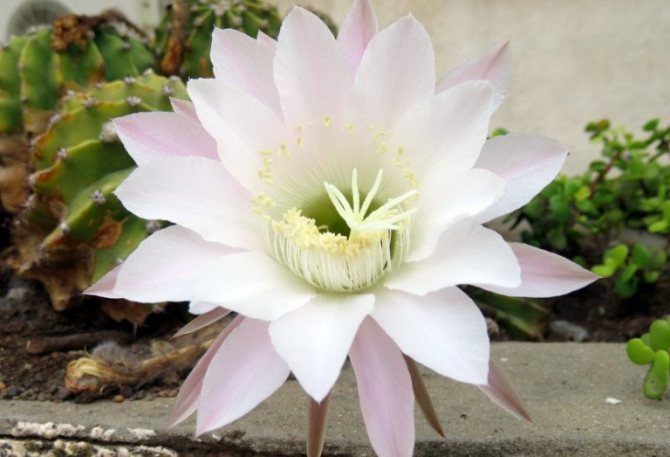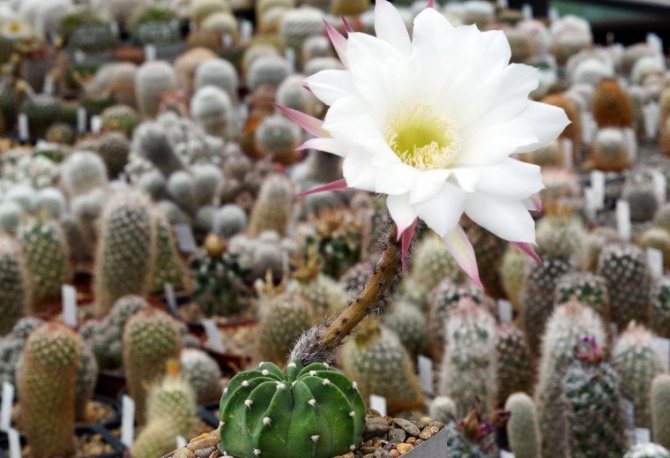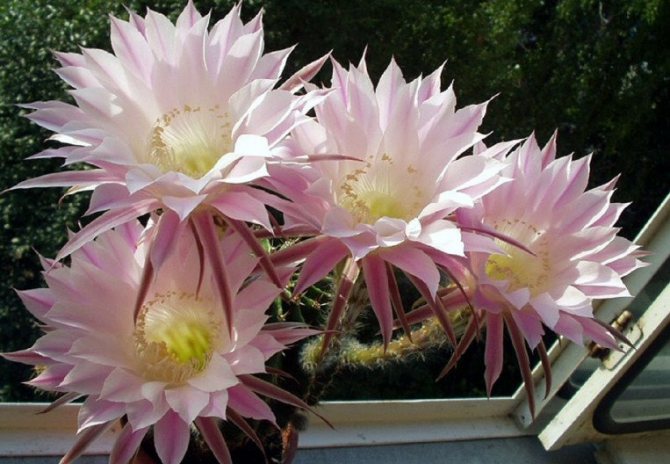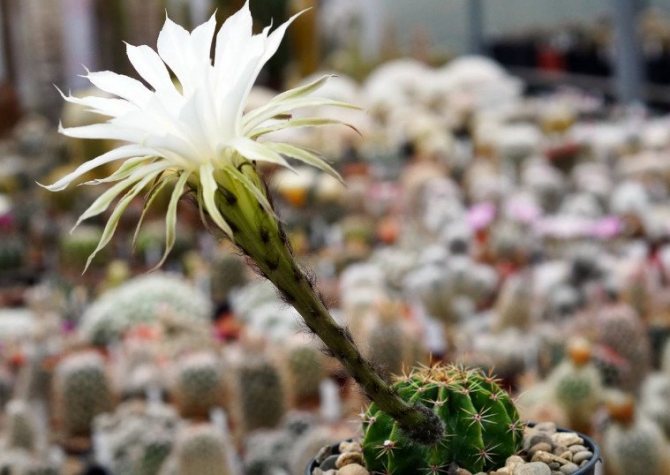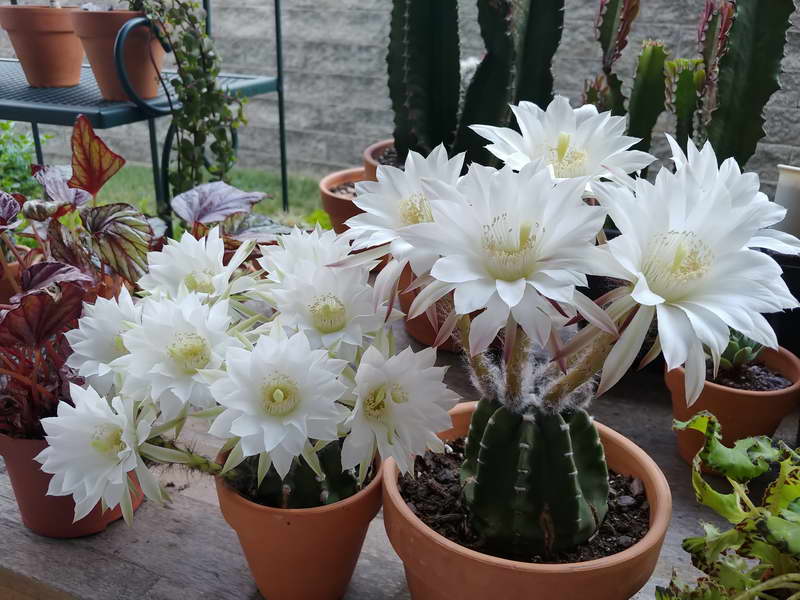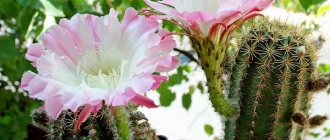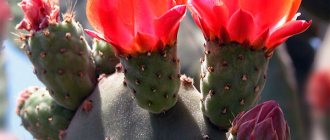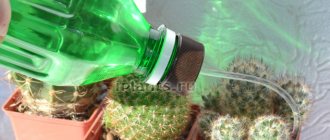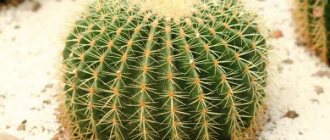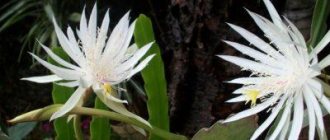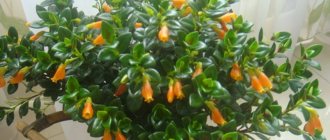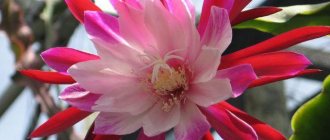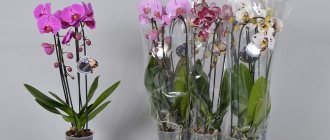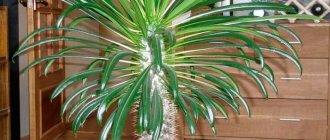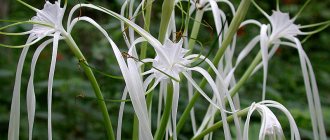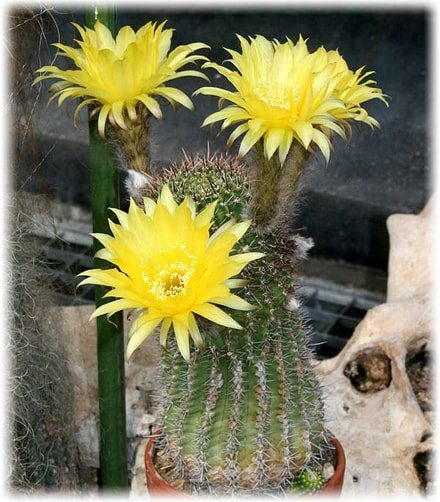
Echinopsis - a plant of the cactus family. South America is considered the homeland, but it is found in many countries with a warm tropical climate: Bolivia, the Andes mountain range, Brazil, Argentina, Paraguay, Uruguay.
There is another name for the "hedgehog" cactus. At the beginning of the 20th century, there were up to 3 dozen plants in the genus. Including hybrid forms, there are more than 100 species in the wild today.
Only a few of them are grown at home. Under natural conditions, the Echinopsis cactus grows on soils enriched with humus, therefore the roots are powerful and developed, and the growth is fast.
At home, due to a lack of humus and moisture, the intensity of development is significantly reduced, but unlike other species, it is suitable for a novice gardener.
Echinopsis often serves as a stock (acceptor) for other types of cacti, that is, buds of other species are grafted onto it.
Description: Large flowers of various colors up to 15 cm in diameter. The petals are arranged in several rows (up to 7 pcs.). There are white, red, yellow, pink colors. Depending on the species, the flowers open at night or in the morning. Some varieties have a strong aroma. The surface of echinopsis is covered with spines of various lengths depending on the variety, some are very sharp and long. Under natural conditions, some of the cacti form impassable thickets. The surface is covered with ribs, on the tops of which light areoles are located, from 3 to 15 emerge from them. spines reaching lengths of 20-30 mm.
Long stem, with a peduncle at the end.
The flowering period is from mid-spring to the first cold snaps. Flowering is gradual over the course of weeks, at first several flowers begin to bloom, after 3 days they wither, but others open up. For a successful and lush flowering, it is necessary to provide a humid climate and a low temperature during the rest period.


Botanical description
Echinopsis is a perennial cactus that grows very slowly. He has a well-developed root system, which grows into several layers of soil. Side shoots are rarely formed on the stem.
Shoots of a young plant are spherical. With age, the shape of the stem gradually becomes elongated. It is covered with upright raised ribs. On their surface are areoles with short white villi. In addition, each areola contains 2-3 sharp spines.
The flowering period lasts from spring to mid-autumn. At this time, 3-4 buds with a diameter of no more than 15 cm bloom on the lateral parts of the shoots. Flowers are located on a long (20 cm) pedicel. Flower petals are arranged in 2-3 rows. They can be yellow, white, orange or purple. In some varieties, flowers exude a pleasant smell.
At the end of flowering, in place of flowers, elongated fruits are formed with juicy pulp and a large number of seeds covered with black skin.
The main signs of echinopsis
This article discusses the main types and names of echinopsis, you will see photos of the most attractive representatives of this species. We will tell you about the basic principles of caring for echinopsis, how to cause its flowering, how to propagate and transplant your cactus.
Types and varieties: descriptions, photos and names
Echiopsis sharp-edged
Echiopsis sharp-edged (E. Oxigona) - the stem is presented in the form of a green ball with a diameter of 5 to 25 cm. Each of them has up to 14 convex ribs with tubercles. On each rib at the same distance, white areoles with spines are clearly visible. The pink flowers can be up to 22 cm in diameter.Fruits 4 cm long are formed in their place.
Sharp-edged cactus echinopsis in the photo:
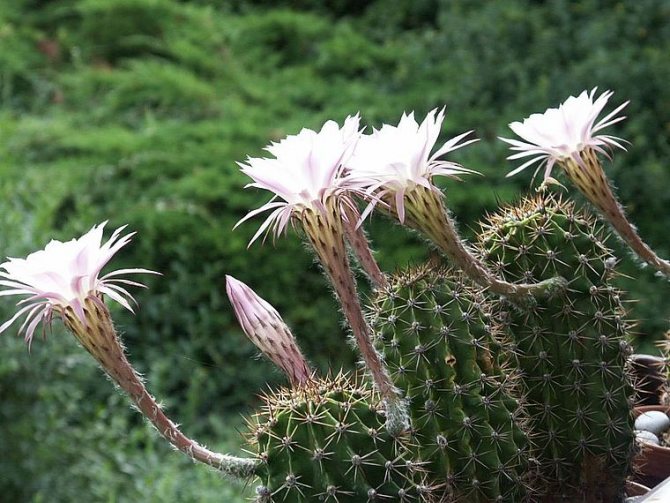

Eirieza
Echiopsis eirieza or erye (E. Eyriesii) - the stem is covered with convex ribs in the amount of 11-19 pieces. White fluffy balls with short sharp spines are clearly visible inside the areoles. The length of the peduncles reaches 25 cm. Pale pink flowers develop on them. The central part of each petal is occupied by a wide dark stripe. This type of cactus has the ability to form a large number of side shoots.
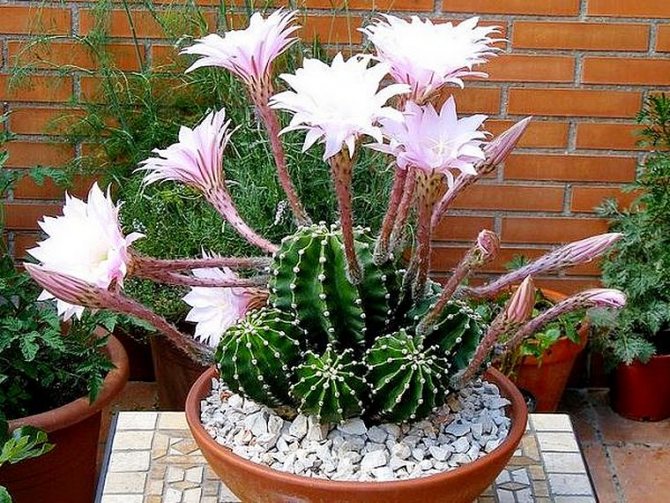

Tubular
Echiopsis tuboflora or tubiflora (E. tubiflora) - the stem of young plants is like a ball, which stretches with age and takes the shape of a cylinder. Convex ribs in the amount of 11–12 with deep tubercles are visible on each shoot. Areolas can be colored in different shades. Attention is drawn to the yellow spines, the tip of which is painted in a dark color. The length of the spines ranges from 2-4 cm. White flowers in the form of a funnel develop on long peduncles.
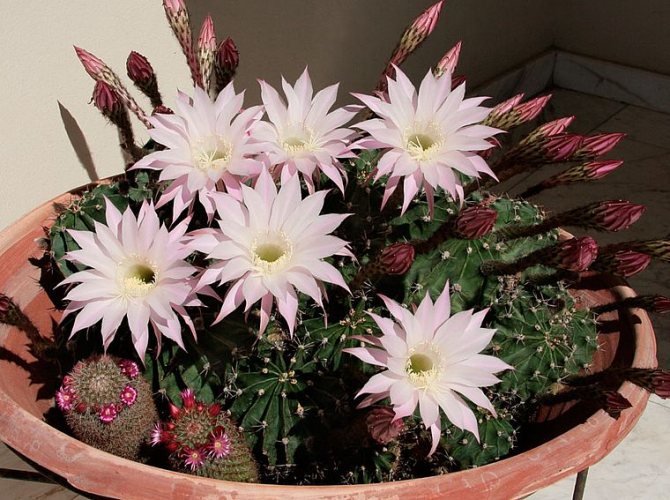

Hook-nosed
Echiopsis hook-nosed (E. Ancistrophora) - the stem has the shape of a flattened ball with a diameter of 8 cm. There are convex tubercles with 3-10 white spines along the length of the ribs. In the central part of the tubercle, there is a long (2.0 cm) brown curved spine. On the sides of the shoots, pink flowers bloom on long peduncles.
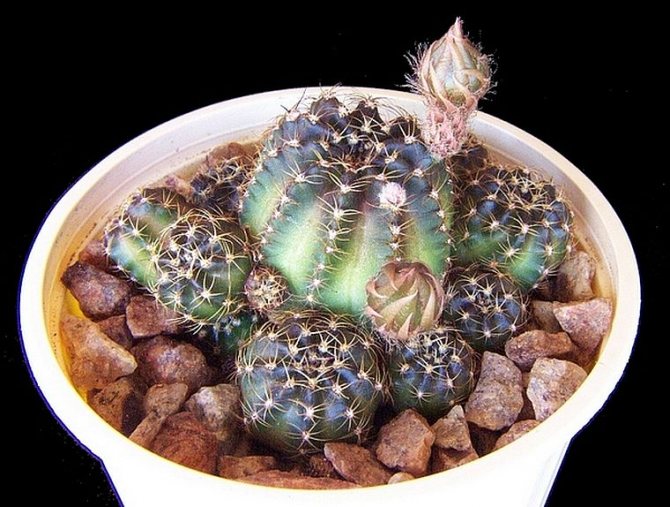

Golden
Echiopsis golden (E. Aurea) - the height of the stem reaches 10 cm. With age, the round stem gradually takes the form of a green cylinder with a large number of lateral stems. Up to 15 convex ribs with brown fluffy areoles are formed on each stem. In the center of each of them there are 4 long (10 cm) brown spines with yellow tops. Bright yellow flowers form in the central or lower part of the shoot.
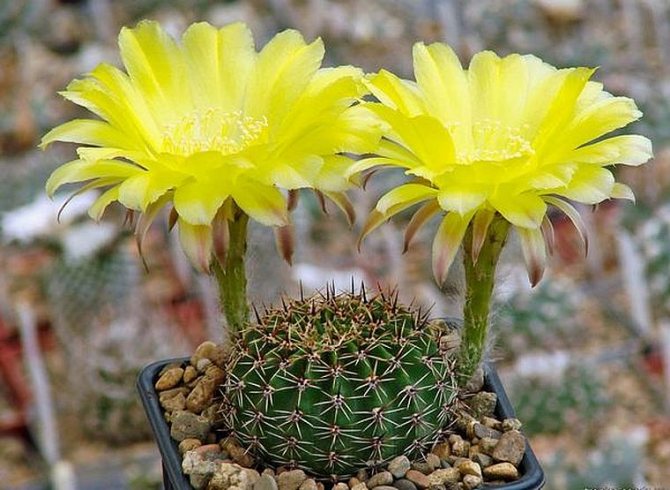

Mamylose
Echiopsis of mamylosa (E. Mamillosa) - the height of the flattened stem can be up to 30 cm. On its surface there are 13–17 ribs with sharp edges and deep tubercles. Up to 12 curved spines 1 cm long emerge from the center of each areola. During the flowering period, white slightly curved flowers up to 15 cm in length appear on the shoot.
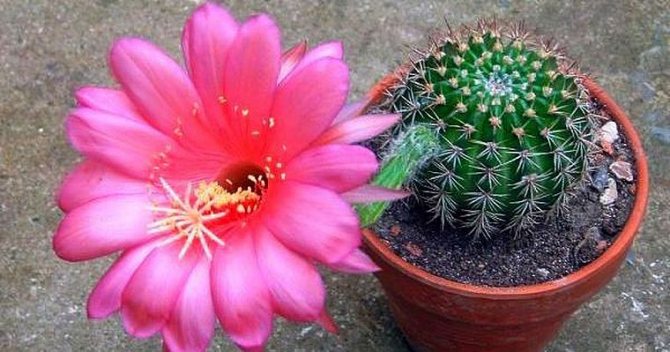

Hybrid
Echiopsis hybrid (E. Hybrid) is an elongated stem covered with convex ribs with areoles. White flowers with wide petals bloom on a long stalk.
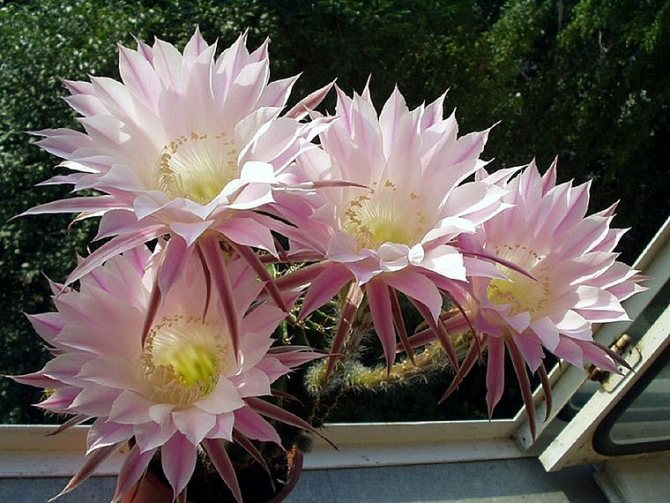

Subdenudata
Echiopsis subdenudata or semi-naked (E. Subdenudata) - with age, the shape of the stem does not change and remains spherical. Its height is 9 cm. Areoles with white hairs and a long (2 mm) spine are rarely located on the surface of the shoot. With the onset of spring, long (20 cm) white flowers bloom on long peduncles.
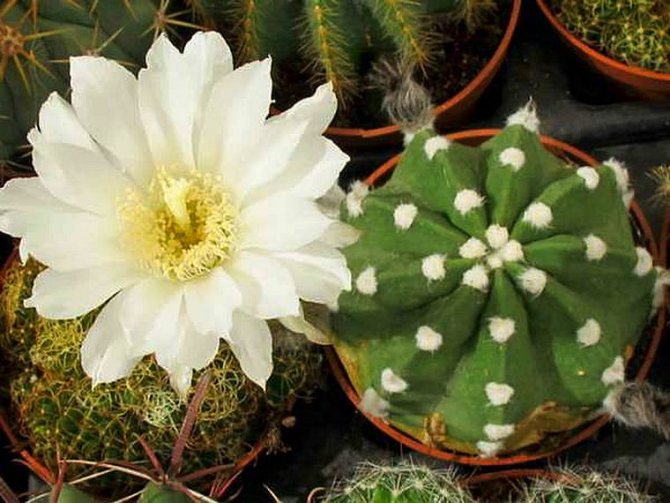

Pachanoi
Pachanoi (E. Pachanoi) - a cactus has the form of a column 6 m high with a large number of lateral stems.In the middle part of the areoles there are 7 yellow or brown spines.
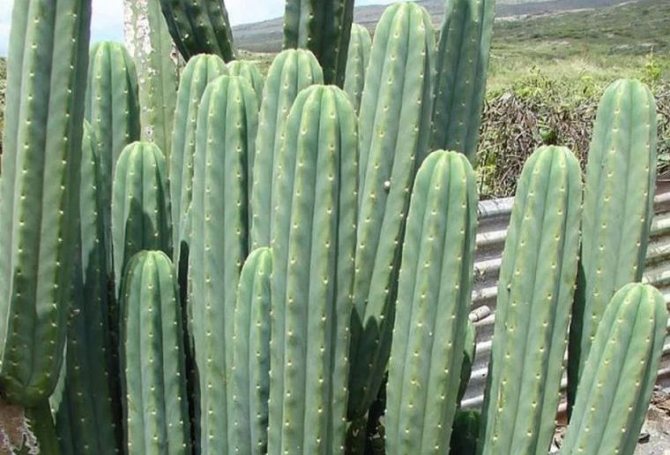

Whitening
Echiopsis kandikans or whitening (E.candicans) - cylindrical stems straight or lodging up to 60 cm in length, and up to 14 cm in diameter. Stems are light green. The flowers are white, funnel-shaped, and the fruits are round.
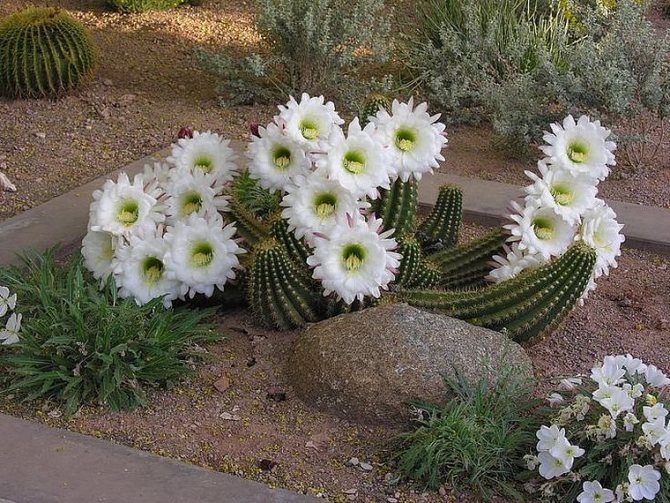

Basic signs
Echinopsis, which in the first years of life resembles a hedgehog and that is why it bears the name of this cute animal, is the most demanded genus of exotic thorns among the world community of flower growers.
The description of a cactus within a taxonomic unit varies considerably.
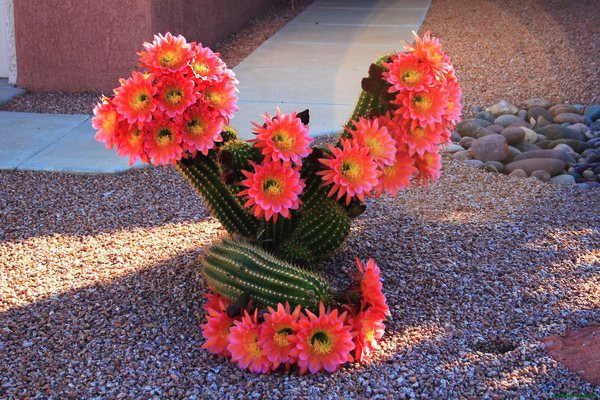

Although there are similar features:
- The presence in young specimens of a spherical stem of all shades of green with a gloss, formed by smooth or bumpy ribs, is considered characteristic. Symmetry is evident. Over time, the cactus takes on a somewhat elongated shape (from a few centimeters in culture - up to 2 meters in natural conditions).
- The presence of fluffy areoles with sharp, more or less long spines of varying hardness are mandatory for these cacti. Each areola contains within one and a half dozen skewers. Flower tubes begin to form from them.
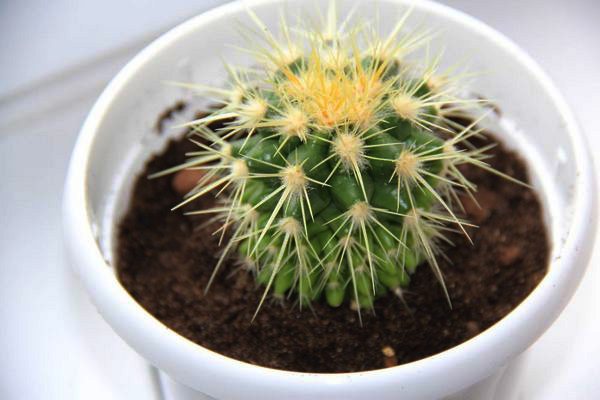

Flowering can occur as early as 3-4 years of age. The formation of peduncles is possible throughout the growing season. The opening of the buds occurs at night or in the morning, and the lifespan of each flower is no more than 3 days. At a time, about 25 open corollas can be counted on one stem, but this is on age cacti.
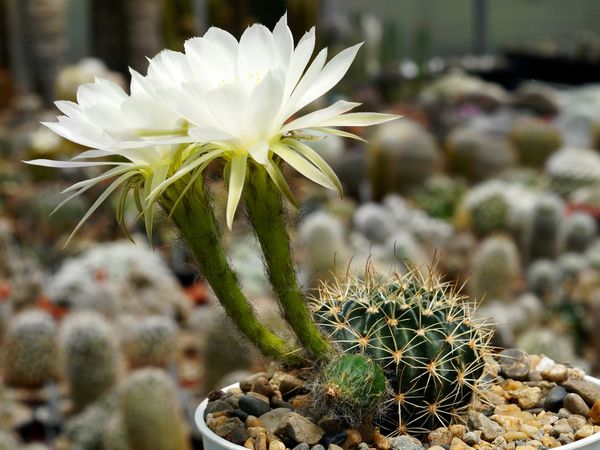

- The plant forms a long (three tens of centimeters) flower tube with hairs in the middle of the stem, on which a large (up to 15 cm) single funnel-shaped flower opens up. The corolla consists of several layers of yellow, white or pink-red petals. Several varieties have a pleasant aroma.
- In many collections, Echinopsis can be found as a base (rootstock) for other types of cacti.
- Echinopsis is distinguished among many plants for its wonderful and at the same time healing healing properties of its pulp. It has antibacterial properties, helps in the treatment of cardiovascular, gastric diseases, arthrosis, hypertension and much more.
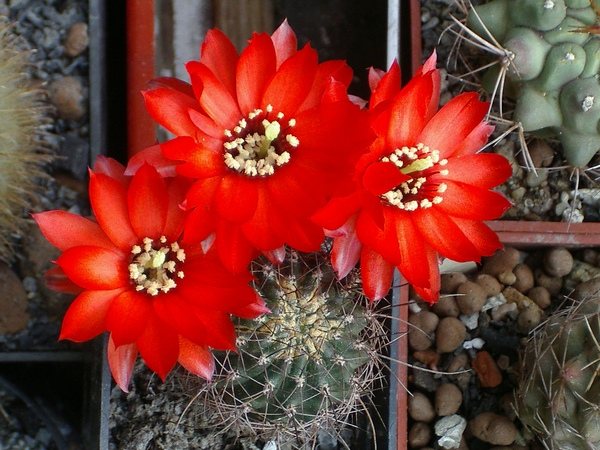

How to care at home
Echinopsis is distinguished by its unpretentiousness and simple care at home.
Where to put the flower, soil
Echinopsis cactus needs good lighting, but no direct sunlight. A window sill from the east or west side is suitable for their location.
As for the soil, it is better to use a ready-made soil mixture for cacti with an acidity level within 6. The soil should be loose and nutritious. The possibility of self-preparation of the soil mixture is also not excluded. To do this, it is necessary to mix in equal amounts sod and leafy soil, sand and fine gravel.
Lighting, temperature, humidity
Echinopsis needs a long day of light. The plant needs shading from the midday sun. Otherwise, sunburn appears on its surface.
The cactus tolerates heat very well. It is recommended to grow the plant at a temperature of 25-28 °. During the dormant period, the cactus pot is transferred to a cool place where the temperature does not exceed 10 °. Thanks to this, the cactus has the opportunity to gain strength before the start of the active growing season, as well as before flowering.
The presence of a tough peel provides the ability to retain moisture even in extreme heat. Therefore, air humidity is not considered a critically important indicator for echinopsis.
Watering
It is recommended to water the plant as the topsoil dries out. For this, settled water with a minimum chlorine content is used.During the period of vegetative growth, the cactus is watered 2-3 times a week, and with the onset of the dormant period, it is better to reduce the frequency of watering to 2-3 times every 2 months.
Fertilizers
From the beginning of spring until the end of the flowering period, Echinopsis needs additional feeding. For this, it is better to use mineral fertilizers, which are applied once a month. In winter, feeding is not performed.
Dormant period
The dormant period for Echinopsis begins at the end of autumn. At this time, it is recommended to place the cactus in a cool room, where the air temperature does not exceed 10 °. If this is not possible, the pot is moved as close as possible to the window glass. At this time, the plant should not be watered and fertilized. Towards the end of the dormant period, the soil needs to be watered a little, accustoming the cactus to watering.
Pruning
Pruning is performed when necessary to rejuvenate the plant or form its crown. The cut site is processed with crushed activated carbon. After a while, new young shoots grow on it.
Transfer
A wide pot of shallow depth is suitable for the growth of echinopsis. It is recommended to replant young plants every year. With age, the transplant is performed 1 time for 3-4 years.
Plants are planted in a soil mixture prepared from sod and leafy soil, sand and fine gravel. In this case, the bottom of the pot must be lined with a layer of fine expanded clay or pebbles. Thanks to this, it will be possible to avoid stagnation of moisture in the soil.
You need to transplant carefully, transferring a lump of earth to another container. This is necessary so as not to damage the plant's root system.
Use in decorative floriculture
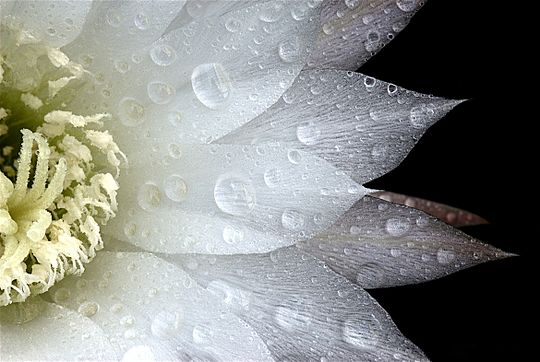

Echinopsis flowers Plant type:
flowering. For the best flowering, it is recommended to keep the plant in one position at all times without turning. Decorative period:
May June. Echinopsis sharp-edged usually forms groups, that is, there are many processes.
Purpose:
used for rock compositions and the creation of a semi-desert landscape, for decorating rooms with artificial light.
Agrotechnics
The soil:
a mixture of leaf and sod land, humus, weathered clay, coarse sand (1.5: 1: 1: 1: 1), add a little broken brick. Care:
does not like spacious dishes and deep planting; the stems of very old plants rejuvenate; a cold and dry wintering is necessary (a period without watering from October to April) at 10 degrees Celsius.
Watering:
regular, drying out of the earthen coma or excessive watering causes the buds to fall off.
Top dressing:
only for large cacti (age 5 and more years) in the summer with mineral dressing (1-1.5 g of complete fertilizer per 1 liter of water).
Lighting:
bright, sunny side.
Reproduction:
seeds and lateral shoots "babies" in spring or summer.
Possible problems:
when choosing a location, it is not recommended to rearrange and turn the plants towards the light source, as this leads to the dropping of the buds.
Reproduction
There are 2 known ways of reproduction of Echinopsis:
- Seeds... They are planted in the soil in early March. Sod and sand are used as a soil mixture, which are pre-calcined. Before sowing, the seeds are soaked for 2-3 hours in a weak solution of manganese. After that, they are laid out on moistened soil, sprinkled with a thin layer of soil. The pot is covered with a transparent film or glass and placed in a room where the air temperature is in the range of 18–20 °. The shelter is removed once a day to moisten the soil and ventilate. The first shoots appear in 20-25 days. When young plants reach a height of 7-10 cm, they can be dived into new pots with prepared soil mixture.
- Children... This method is combined with cropping. Cut cuttings are used for rooting.Their lower end must dry out for 3-4 days. After that, it is placed in moistened sand. Young roots appear after 1-2 weeks. After rooting, the young plant can be transplanted.
For rooting, you can also use cactus babies, which, after separation and drying, are placed under a film in wet sand.
The simplest and most effective method of reproduction of echinopsis is the rooting of children or cuttings.
How echinopsis cactus reproduces
Echinopsis Subdenudata and others can be easily propagated by cuttings and seeds. Each method has its own characteristics.
Germinating seeds
Opuntia cactus - varieties, home care
It is possible to grow a succulent from seeds, the process takes a long time, but it allows you to get a rather rare plant. Procedure step by step:
- The container is filled with suitable earth.
- Seeds are sown in it; you do not need to fill them on top.
- Spray lightly from a spray bottle.
- Cover the container with film or glass and put it in a warm place.
- Periodically, the pot should be ventilated, if necessary, moisten the soil.
- After a couple of weeks, the first shoots will appear.
Important! A transplant to a permanent place is carried out after the cacti have thorns.
Rooting babies
Cacti often produce babies that are easy to propagate. The method is much simpler and faster. The baby is carefully separated from the main plant, dried a little. Then you can simply plant it in a container with prepared soil.
As a rule, the shoots take root quickly. However, they often lose the properties of the mother flower and rarely bloom.
Diseases and pests
Echinopsis is resistant to the development of diseases and damage by pests. Among the dangerous pests that threaten the plant are spider mites, scale insects and mealybugs. To combat them, it is recommended to use special preparations.
You can also achieve good results as a result of using folk recipes: infusion of garlic or onions. They are sprayed on the plant until the insects disappear.
From diseases, cactus can be threatened by root rot, which develops when the soil is waterlogged. Chemicals are also used to fight the disease. In addition, it is necessary to change the watering schedule of the cactus.
Care errors and problems
When growing a cactus at home, the likelihood of the problems described in the table is not excluded.
| Problem | Cause |
| Brown spots appear on the stem | Direct sunlight on the plant |
| Withering shoots | Low temperature during dormant period |
| Pulling and deformation of the stem | Lack of lighting |
| Shoots turn reddish | Use for watering hard water |
| Rapid growth and lack of flowering | Excessive nitrogen in the soil |

